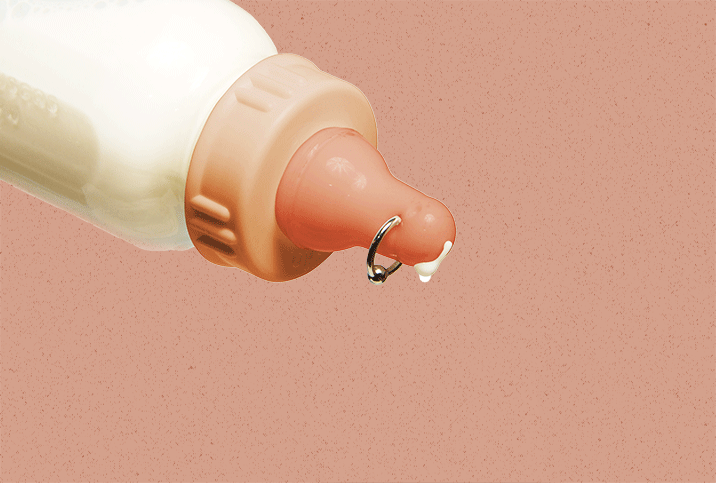Female Genital Piercing: Rewarding or Risky? It Depends

A bad piercing can equal a bad sex life, pain or disfiguration. Not all people who perform female genital piercings (genital piercers) are knowledgeable and can be trusted. Let's learn about the different types of genital piercings and which female genital piercing options you should avoid.
What are female genital piercings?
For starters, vaginas don't get pierced; vulvas do. Genital piercings for women can be a safe and unique way to add decoration and potentially intense pleasure to your lady bits.
Women or people assigned female at birth (AFAB) should take genital piercing seriously. Research is your responsibility. It's not something to go into blindly. The majority of people with genital piercings have taken many months, if not longer, to consider the procedure, a 2023 study reported.
The average age for women considering genital piercings is 27, but the average age to move ahead with the piercing was 28, according to 2005 survey respondents.
A bad piercing can cause severe symptoms, such as scarring contributing to urethral obstruction, a 2012 study suggests. Take your time, interview piercers and consider the right piercing type for your body and lifestyle.
Your piercing options
Before you go rushing to the nearest piercing place, you’ll need to decide which part you want to decorate. Then, you'll want to speak to a professional piercer to determine if your anatomy aligns with the piercings you prefer.
Your options for female genital piercing are:
- The clitoral hood
- The clitoris itself
- Inner and outer labia
- Urethral opening
- Pubic mound
- Perineum
You will also need to decide HOW you want to decorate. What kind of jewelry will you choose?
What is the best jewelry for female genital piercings?
The best jewelry for a piercing will depend on where you are pierced. Vulva piercing (sometimes erroneously termed vaginal piercing) should be taken seriously. These intimate piercings also serve as a form for some women to express themselves in a unique way.
Jewelry can take a large part in this form of sexual self-expression.
The clitoris hood, for example, can be adorned with rings or barbells. Speak with your piercer to learn more about the right type of jewelry for your piercing.
What kind of jewelry should I get if I'm allergic to nickel?
If you have a nickel allergy, you aren't alone. Up to 30 percent of people with body piercings have a nickel allergy, according to UMass Chan Medical School. You can still continue with your piercing, but you'll need to spend a little more on high-quality jewelry made from titanium.
Titanium doesn't contain nickel. If you suspect you have an allergy to nickel, you'll want to stick with titanium genital piercing jewelry to stay on the safe side. Let your piercer know about your allergy, and they can help show you the best nickel-free jewelry for your piercing.
Why do people get female genital piercings?
Female and male genital piercings are relatively common. At one studio, genital piercings composed not quite 4 percent of the total piercings performed in 2016, with 217 women's genital piercings completed overall at Infinite Body Piercings studio in Baltimore and Philadelphia. The clitoral hood piercing was the most popular.
Women cited three main reasons for considering genital piercing, according to the 2023 report:
- Sexual self-expression (79 percent)
- Improved sexual pleasure (77 percent)
- Uniqueness (71 percent)
The goal of piercings to increase an intimate partner's pleasure is on the low end of the motivations scale, falling at a mere 10 percent compared to the 89.9 percent who were most interested in the aesthetics or the roughly 36 percent citing sexual pleasure, according to a 2014 report.
About 21 percent of survey respondents aged 18-29 stated they liked genital piercings for women, a 2017 Statistica report shared. Both female and male genital piercings are common for decorative and potentially sexually satisfying characteristics.
What are the different types of female genital piercings?
Although some people may tell you otherwise, there are a few female genital piercings so risky that legit piercers won't touch them. We'll fill you in on why you should skip them. Fortunately, there are plenty of other fantastic options as you'll view below.
Whether you are looking for pleasure, to decorate your downstairs or a combination of both—you have a big decision ahead of you. For looks and pleasure, you might go with the vertical clitorus hood piercing. If you want a piercing for appearance only, read all about the outer labia piercing.
What is a Vertical Clitoris Hood (VCH) piercing?
A vertical clit hood piercing (VCH) is pierced through the hood covering the clitoris vertically. It is popular and suited to most vulva anatomy.
The jewelry gauge of a VCH piercing varies just like all female genital piercings. The curved barbell is the most common jewelry selection, so the jewelry grazes the clitoris.
"This is the most popular vulva piercing as it can add sensation, it looks lovely and most (though not all) hoods are suited to it. Approximately 80 to 90 percent of vulvas have enough prepuce (the protective fold of hood tissue above the clitoris) in which jewelry can be placed for a safe and stimulating piercing," said Elayne Angel, author of The Piercing Bible (Penguin Random House, 2021) and a Detroit-based genital piercing pioneer.
What is the average healing time of a VCH?
The average minimum healing time is from 6 to 8 weeks.
How do I know If I can get a VCH piercing?
Angel created a simple way to self-assess your suitability for this piercing, or the Q-tip test. Roughly 80 to 90 percent of vulvas are suited to the VCH.
How does the Q-tip test work for a VCH?
A VCH piercing is suitable for most clitoris hoods, but not all.
To check the depth of your hood, de-fluff the Q-tip, lubricate the Q-tip, and gently slide it beneath the protective hood of the clitoris. If you can see little to no cotton (if your hood covers most of the cottony tip), you are likely a candidate for the VCH piercing.
Why do people get VCH piercings?
Genital piercings can be both decorative and (sensationally) practical, though not all female genital piercings promise pleasure.
The VCH is an exception: it is often considered aesthetically pleasing with numerous jewelry options and the potential for sexual pleasure.
What is a Horizontal Clitoris Hood (HCH) piercing?
A horizontal clitoris hood piercing (HCH) is similar to the VCH, though the piercing penetrates the hood of the clitoris horizontally but doesn't pierce through beneath the hood.
While aesthetically fun and pleasing, the HCH piercing may not necessarily add sensation or sexual enhancement.
What is the average healing time of an HCH?
The average minimum healing time is 6 to 8 weeks.
How do I know If I can get an HCH piercing?
The Q-tip test is not designed to work here, so if you are thinking about the HCH piercing, it is worth consulting an expert genital piercer. If your genitals are asymmetrical, the jewelry may twist or rotate, causing healing issues and general discomfort.
Although an HCH piercing can be potentially stimulating, you should not invest in this piercing solely for additional sexual stimulation.
"For an HCH to be stimulating, your clitoris must be exposed, the piercing perfectly placed… Then the bead on a ring can touch your clitoris to add sensation; otherwise, the HCH will be… a hood ornament," Elayne Angel said.
Why do people get HCH piercings?
The HCH piercing is popular because people find it attractive. While there's no real promise of extra orgasms it is a fun, visible piercing. Jewelry options for the HCH piercing include diamante beaded rings. Mix it up as you would any accessory.
What is a clitoris piercing?
A clitoral glans piercing or clit piercing is often incorrectly referred to as a VCH or HCH piercing. The VCH and HCH do not pierce any part of the clitoris or clitoral glans, they protect and shield it. The clitoris piercing does penetrate the clitoral glans.
There are a number of female genital piercings piercers refuse to perform due to the high potential for adverse health risks—and the clitoris is one of those piercings.
How do I know if I can get a clitoris piercing?
Anatomy makes most bodies incompatible with the clitoris piercing. Expert consultation and discussion are essential, but most piercers will turn you away.
Risks of piercing the clitoral glans include scarring, migration, rejection, ongoing discomfort or pain and complete loss of sexual enhancement and sensation.
Do clitoris piercings hurt?
Yes. But a dead clitoris would hurt infinitely more.
Is a clitoris piercing the same as a clitoral hood piercing?
No. The clit piercing actually penetrates the clitoral glans, while clitoral hood piercings penetrate the protective fold of soft skin covering the clitoris. The clitoris is located beneath the hood, just like the engine that runs your car.
What is an outer labia piercing?
Outer labia piercings are located along the thick fleshy outer ‘lips’ of the vulva. This female genital piercing is visible and simple, though it does take significant time and care to heal.
However, outer labia piercings are not likely to enhance sexual stimulation for the piercee, though a sexual partner might experience this benefit.
What is the average healing time for outer labia piercing?
The average healing time for an outer labia piercing is 3 to 4 months.
Why does it take months for this piercing to heal? The outer labia genital piercing penetrates thick flesh constantly exposed to the trauma of general life. Proper aftercare should result in a fully healed labia piercing
How do I know if I can get an outer labia piercing?
This common piercing is not heavily dependent on anatomy, but your own comfort needs to be taken into account. An incorrectly placed outer labia piercing will be irritating or painful. Talk to your piercer about placement to avoid difficulty in healing.
Why do people get outer labia piercings?
Often pierced in pairs, some people find outer labia attractive. Outer labia piercings are popular partially due to their visibility, even though they present no real opportunity for additional stimulation. Some people like these piercings so much that they opt for ladders, or rows of outer labia piercings.
What is an inner labia piercing?
The inner labia piercing is located on the labia minora, which are folds of fine skin located within the outer labia of the vulva. Inner labia genital piercings are common. Seek an expert piercer for correct placement and jewelry to avoid unnecessary complications, as with all female genital piercings.
What is the average healing time for inner labia piercing?
The average minimum healing time for an inner labia piercing is 4 to 8 weeks.
How do I know if I can get an inner labia piercing?
The inner labia piercing location is important so you can sit comfortably, legs crossed or not. You can’t get your inner labia pierced without enough skin. In other words, you need to have enough tissue for a safe inner labial piercing (and not everyone does).
Why do people get inner labia piercings?
People get inner labia piercings because they admire how they look. These piercings can provide new sensations for male partners or people with a penis.
What is a Christina (or Venus) piercing?
A Christina, or Venus piercing, is a decorative surface piercing on the pubic mound. It is considered a genital piercing, but it pierces the surface. The piercing enters the vulva just above the hood and exits the pubic mound upwards.
Many piercers are more comfortable performing this piercing than other female genital piercings.
What is the average healing time?
The average minimum healing time for a Christina piercing is 6 to 9 months. Wait the recommended minimum healing time before changing jewelry or getting too physical.
Surface piercings, however, are notoriously difficult to heal. The Christina genital piercing is easily knocked around during physical contact or caught on clothing, potentially prolonging healing and increasing the risk of scarring.
How do I know if I can get a Christina piercing?
Pinch the skin of your public mound to determine if there is enough flesh to pierce. Is where the vulva divides into two outer labia deep enough for the bottom of the barbell to sit comfortably without protruding?
If your anatomy means the Christina piercing would be ill-placed, or if your pubic mound is quite pronounced, it may not be the right piercing for you.
Why do people get Christina piercings?
This female genital piercing is solely for looks. It is popular with people who want to add obvious or bold sparkles.
What is a triangle piercing?
Triangle piercings are similar to the HCH (the horizontal clitoris hood), but they are placed slightly below the clitoral shaft, not in front of it like the HCH.
This piercing is tricky. It could cause permanent damage to the clitoral glans or clitoral shaft. Done correctly, it can provide incredibly unique sensations when compared to other female genital piercings.
“I have had multiple clients confide that they had never experienced an orgasm until after I performed their triangle piercings,” Angel said.
What is the average healing time for a triangle piercing?
The average minimum healing time for a triangle piercing is 3 to 4 months.
How do I know if I can get a triangle piercing?
Consult an experienced piercer. The triangle piercing is considered dangerous—you don't want a rookie handling this one. The piercer will check for veins (which should not be pierced) and pinch behind the clitoral glans at the base of the hood to help ensure your body is suited to the piercing.
Why do people get triangle piercings?
A population of people are not anatomically suited to the triangle. A well-executed triangle piercing is reported to feel good, in a way you haven't experienced previously, according to feedback from people who have one.
What is a fourchette piercing?
Ever heard of guiche piercing? It's a word for the piercing of the male perineum. Although people associate the term "perineum" with male anatomy, all sexes have the same area of skin.
A female fourchette piercing is performed on the perineum, but vertically like the vulva, to help ensure comfort as the jewelry lays along the bodily surface.
What is the average healing time of a fourchette piercing?
The average minimum healing time for a fourchette piercing is 6 to 8 weeks, though they can be difficult to heal.
How do I know if I can get a fourchette piercing?
Like many female genital piercings, the natural design of your body will determine if you can have that area safely pierced. A lip or fold of tissue in the region is necessary. If you have scarring in the area from childbirth, you want to skip this piercing.
Why do people get fourchette piercings?
The fourchette piercing, done right, is highly likely to increase erotic sensation.
What is a Princess Albertina piercing?
This rare female genital piercing has the potential to feel great but is not without risk. The Princess Albertina pierces the urethral opening, exiting within the opening of the vagina. It uses a 10-gauge or 8-gauge captive bead ring with a small diameter.
Expect new, unusual and potentially uncomfortable sensations if you have no experience with urethral play and stimulation.
What is the average healing time of a Princess Albertina?
The average healing time for a Princess Albertina piercing is 4 to 6 weeks. This genital piercing requires complete sexual abstinence during the healing period.
How do I know if I can get a Princess Albertina piercing?
You'll need a full consultation with an experienced professional body piercer.
Why do people get Princess Albertina piercings?
If you have played with urethral stimulation, this genital piercing may build on those sensations. If urethral play is new to you, the stimulation may initially be uncomfortable. Your body will need time to adjust.
The Princess Albertina piercing is neither simple nor easy. It does not come without risk.
What is a Princess Diana piercing?
The Diana was named by Master Piercer Elayne Angel, who pierced the first Princess Diana piercing on a woman named Diana. That person was not Princess Diana, unfortunately.
A Princess Diana piercing, or Duke piercing, is most commonly performed in pairs, penetrating the clitoral hood on either side (rather than in the center such as with a VCH).
What is the average healing time?
The average healing time of a Princess Diana piercing is 4 to 8 weeks.
How do I know if I can get a Princess Diana piercing?
Many folks have a clitoral hood that sits protectively over the clitoris, such as for a VCH or HCH, however, a successful Princess Diana piercing requires a wide enough hood to support a piercing on either side.
Why do people get Princess Diana piercings?
Princess Diana piercings are VCH piercings placed on the left and right of the clitoral hood. The posts or balls from the barbells can graze the clitoris. People get the Princess Diana when they want royally fantastic orgasms.
What is an Isabella piercing?
Isabella piercings are extremely uncommon, and the piercing is considered highly dangerous and painful. The Isabella piercing begins at the bottom of the clitoris above the urethra and penetrates upwards through the clitoral shaft, exiting above the clitoral hood.
What risks are associated with an Isabella piercing?
Piercing the clitoral shaft includes the following potential problems:
- Loss of partial, total, permanent or temporary clitoral sensation
- Nerve damage
- Hemorrhage
A healed Isabella piercing may present the same risks as a fresh piercing.
The dangers associated with the Isabella piercing outweigh the potential benefits. The Nefertiti piercing was created to "safely" mimic the Isabella. Unfortunately, the Nefertiti is equally unsafe.
How do I know if I can get an Isabella piercing?
A reputable piercer will not perform an Isabella.
What is a Nefertiti piercing?
Like the Isabella piercing, the Nefertiti is no joke. A Nefertiti is equally as high-risk as the Isabella piercing. It's like a deep VCH that travels a far distance underneath the skin and exists at the bottom of the pubic mound.
"The risk is a real-world danger and not just a theoretical one. I cannot in good conscience be supportive of anyone getting either of these piercings," Angel said.
What else should I know about genital piercings?
Indulging in female genital piercings requires more than hitting the local tattoo shop and taking your pants off.
Here are the basic body piercing facts you should know:
- A safe piercing studio should be clean, sterile and smoke-free.
- Look for a medical-grade autoclave for jewelry and tool sterilization.
- The piercing studio should have one room for piercing and another for sterilizing equipment—cross-contamination is the cause of many infections.
- Look for the sharps container. Ask if you can’t see one.
- All needles and tools should be opened in front of you so you know they are sterilized.
- If anyone comes near you with an ear-piercing gun, sprint out of there.
- A good piercer provides aftercare guidance, advice and answers questions.
Are genital piercings safe?
Female genital piercings are incredibly popular and can be considered safe when performed by an experienced piercer correctly, the same as penis piercings and other male genital piercings.
Titanium is the metal of choice, followed by surgical stainless steel (nickel, a common allergen, may be present in surgical stainless steel). High-quality gold is another popular option. Speak with your piercing specialist to determine the best option for you and your piercing.
There are risks with all forms of body modification. If you are going under the needle, listen to your body piercer and reference the Association of Professional Piercers (APP).
"Training required for piercers and regulation of piercing studios is inconsistent, you can’t assume basic safety standards are in place in your area. Your safety is in your own hands, and you need to be an educated consumer," the APP said.
Make sure to clean the area, look for signs of infection around the piercing area and call your doctor if you have any questions during the healing process.
How do I find a genital piercer I can trust?
Finding the right person to put those decorations where you want them can be a challenge. It takes more than a quick Google search.
- Ask your potential piercer about their experience and education.
- Walk out if you’re not welcomed in.
- Ask for a consultation to determine suitability for the piercing. No consultation is a no-trust situation.
- How long have they been piercing genitals? Have they got experience with the piercing you desire?
- Do you feel confident they provided you with sufficient information covering risks, complications, aftercare, healing and jewelry selection prior to the piercing?
- Is the piercer openly educating you about the specific genital piercing?
- Do you like the energy of the piercer and feel comfortable with them?
- Trust your gut.
What are the healing and aftercare essentials for genital piercings?
You will often get mixed advice on how to care for your new bling. Your piercer should offer advice similar to the piercing tips from the APP.
Genital piercing aftercare tips:
- Your piercer should cover aftercare with you verbally, and provide more detailed information printed or digitally.
- The APP recommends cleaning all piercings with the industry-standard packaged sterile saline water for aftercare.
- Avoid piercers that recommend soaps or ointments for aftercare.
- Once pierced, do not touch the jewelry or you run the risk of infection or inflammation.
- Any sexual activity during the health process should be gentle. Stop the activity if you feel sore or tender. Barrier protection is required throughout the healing process.
General new piercing cleaning tips include:
- After thoroughly washing your hands, rinse the piercing with saline solution or a soaked cotton pad.
- Rinse thoroughly with water to remove the cleaning solution.
- Dry gently with a paper towel or a clean disposable cloth.
Listen to your body and speak to your healthcare provider if you have any questions or concerns.
Safe, yet pleasurable?
Female genital piercings can be safe and potentially enjoyable, but there are serious risks, especially for certain piercings.
Redness, irritation and some localized swelling are normal. If the irritation and discomfort don't decrease, the bleeding is consistent or you notice something doesn't feel right, immediately call your doctor.


















